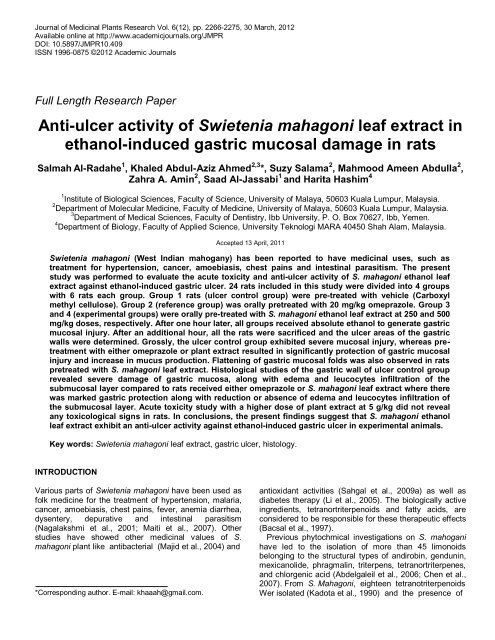Download Complete Issue - Academic Journals
Download Complete Issue - Academic Journals
Download Complete Issue - Academic Journals
Create successful ePaper yourself
Turn your PDF publications into a flip-book with our unique Google optimized e-Paper software.
Journal of Medicinal Plants Research Vol. 6(12), pp. 2266-2275, 30 March, 2012<br />
Available online at http://www.academicjournals.org/JMPR<br />
DOI: 10.5897/JMPR10.409<br />
ISSN 1996-0875 ©2012 <strong>Academic</strong> <strong>Journals</strong><br />
Full Length Research Paper<br />
Anti-ulcer activity of Swietenia mahagoni leaf extract in<br />
ethanol-induced gastric mucosal damage in rats<br />
Salmah Al-Radahe 1 , Khaled Abdul-Aziz Ahmed 2,3 *, Suzy Salama 2 , Mahmood Ameen Abdulla 2 ,<br />
Zahra A. Amin 2 , Saad Al-Jassabi 1 and Harita Hashim 4<br />
1 Institute of Biological Sciences, Faculty of Science, University of Malaya, 50603 Kuala Lumpur, Malaysia.<br />
2 Department of Molecular Medicine, Faculty of Medicine, University of Malaya, 50603 Kuala Lumpur, Malaysia.<br />
3 Department of Medical Sciences, Faculty of Dentistry, Ibb University, P. O. Box 70627, Ibb, Yemen.<br />
4 Department of Biology, Faculty of Applied Science, University Teknologi MARA 40450 Shah Alam, Malaysia.<br />
Accepted 13 April, 2011<br />
Swietenia mahagoni (West Indian mahogany) has been reported to have medicinal uses, such as<br />
treatment for hypertension, cancer, amoebiasis, chest pains and intestinal parasitism. The present<br />
study was performed to evaluate the acute toxicity and anti-ulcer activity of S. mahagoni ethanol leaf<br />
extract against ethanol-induced gastric ulcer. 24 rats included in this study were divided into 4 groups<br />
with 6 rats each group. Group 1 rats (ulcer control group) were pre-treated with vehicle (Carboxyl<br />
methyl cellulose). Group 2 (reference group) was orally pretreated with 20 mg/kg omeprazole. Group 3<br />
and 4 (experimental groups) were orally pre-treated with S. mahagoni ethanol leaf extract at 250 and 500<br />
mg/kg doses, respectively. After one hour later, all groups received absolute ethanol to generate gastric<br />
mucosal injury. After an additional hour, all the rats were sacrificed and the ulcer areas of the gastric<br />
walls were determined. Grossly, the ulcer control group exhibited severe mucosal injury, whereas pretreatment<br />
with either omeprazole or plant extract resulted in significantly protection of gastric mucosal<br />
injury and increase in mucus production. Flattening of gastric mucosal folds was also observed in rats<br />
pretreated with S. mahagoni leaf extract. Histological studies of the gastric wall of ulcer control group<br />
revealed severe damage of gastric mucosa, along with edema and leucocytes infiltration of the<br />
submucosal layer compared to rats received either omeprazole or S. mahagoni leaf extract where there<br />
was marked gastric protection along with reduction or absence of edema and leucocytes infiltration of<br />
the submucosal layer. Acute toxicity study with a higher dose of plant extract at 5 g/kg did not reveal<br />
any toxicological signs in rats. In conclusions, the present findings suggest that S. mahagoni ethanol<br />
leaf extract exhibit an anti-ulcer activity against ethanol-induced gastric ulcer in experimental animals.<br />
Key words: Swietenia mahagoni leaf extract, gastric ulcer, histology.<br />
INTRODUCTION<br />
Various parts of Swietenia mahagoni have been used as<br />
folk medicine for the treatment of hypertension, malaria,<br />
cancer, amoebiasis, chest pains, fever, anemia diarrhea,<br />
dysentery, depurative and intestinal parasitism<br />
(Nagalakshmi et al., 2001; Maiti et al., 2007). Other<br />
studies have showed other medicinal values of S.<br />
mahagoni plant like antibacterial (Majid et al., 2004) and<br />
*Corresponding author. E-mail: khaaah@gmail.com.<br />
antioxidant activities (Sahgal et al., 2009a) as well as<br />
diabetes therapy (Li et al., 2005). The biologically active<br />
ingredients, tetranortriterpenoids and fatty acids, are<br />
considered to be responsible for these therapeutic effects<br />
(Bacsal et al., 1997).<br />
Previous phytochmical investigations on S. mahogani<br />
have led to the isolation of more than 45 limonoids<br />
belonging to the structural types of andirobin, gendunin,<br />
mexicanolide, phragmalin, triterpens, tetranortriterpenes,<br />
and chlorgenic acid (Abdelgaleil et al., 2006; Chen et al.,<br />
2007). From S. Mahagoni, eighteen tetranotriterpenoids<br />
Wer isolated (Kadota et al., 1990) and the presence of

















